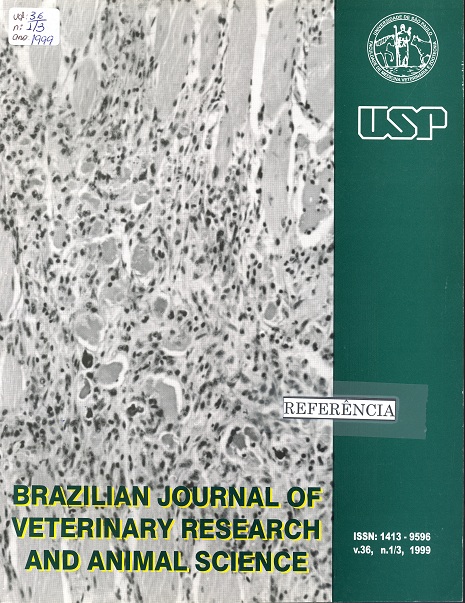Prevalence of DEA 1 canine blood group system in dogs (Canis familiaris, Linnaeus, 1758) reared in Brazil
DOI:
https://doi.org/10.1590/S1413-95961999000100004Keywords:
Blood groups, Blood grouping and crossmatching, Blood transfusion, DogsAbstract
Up to the present, the DEA 1 system has been regarded as the most important dog blood group as far as blood transfusion is concerned. It occurs because the DEA 1 system is highly antigenic and may elicit the production of alloantibodies in a DEA 1 negative recipient, following a transfusion with DEA 1 positive red cells. As a consequence, the recipient will develop a hemolytic transfusion reaction if it receives a second transfusion with DEA 1 type cells. The frequency of appearance of the DEA 1 system is well known in other countries but no information was available for dogs reared in Brazil. In the present experiment 150 dogs were typed, using specific reagents purchased from "The Immunohematology and Serology Laboratory" of Michigan State University, in order to clarify the prevalence of the DEA 1 system (1.1 and 1.2 subgroups) in pure breeds and mongrel dogs reared in Brazil and referred to the Veterinary Hospital of São Paulo State University. The results obtained showed a general prevalence of 91.3% for the DEA 1 system, comprising 51.3% of DEA 1.1 type dogs, while 40% of the animals were positive for DEA 1.2 type. Only 8.7% of tested dogs were negative for DEA 1 system. The prevalence found in this study for dogs reared in Brazil is higher than those ones, described by foreign authors, for dogs reared in other countries. Moreover, through a statistic study, it was found that the potential risk for the occurrence of a hemolytic transfusion reaction in a mongrel dog reared in Brazil is minimum.Downloads
Download data is not yet available.
Downloads
Published
1999-01-01
Issue
Section
VETERINARY MEDICINE
License
The journal content is authorized under the Creative Commons BY-NC-SA license (summary of the license: https://
How to Cite
1.
Novais AA, Santana AE, Vicentin LA. Prevalence of DEA 1 canine blood group system in dogs (Canis familiaris, Linnaeus, 1758) reared in Brazil. Braz. J. Vet. Res. Anim. Sci. [Internet]. 1999 Jan. 1 [cited 2024 Apr. 19];36(1):23-7. Available from: https://www.revistas.usp.br/bjvras/article/view/5775





